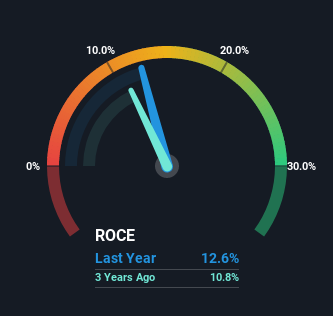- South Africa
- /
- Industrials
- /
- JSE:KAP
KAP Industrial Holdings (JSE:KAP) Has More To Do To Multiply In Value Going Forward

If you're not sure where to start when looking for the next multi-bagger, there are a few key trends you should keep an eye out for. Amongst other things, we'll want to see two things; firstly, a growing return on capital employed (ROCE) and secondly, an expansion in the company's amount of capital employed. Ultimately, this demonstrates that it's a business that is reinvesting profits at increasing rates of return. In light of that, when we looked at KAP Industrial Holdings (JSE:KAP) and its ROCE trend, we weren't exactly thrilled.
What is Return On Capital Employed (ROCE)?
If you haven't worked with ROCE before, it measures the 'return' (pre-tax profit) a company generates from capital employed in its business. The formula for this calculation on KAP Industrial Holdings is:
Return on Capital Employed = Earnings Before Interest and Tax (EBIT) ÷ (Total Assets - Current Liabilities)
0.13 = R2.5b ÷ (R27b - R7.7b) (Based on the trailing twelve months to December 2021).
Therefore, KAP Industrial Holdings has an ROCE of 13%. By itself that's a normal return on capital and it's in line with the industry's average returns of 13%.
See our latest analysis for KAP Industrial Holdings

Above you can see how the current ROCE for KAP Industrial Holdings compares to its prior returns on capital, but there's only so much you can tell from the past. If you'd like, you can check out the forecasts from the analysts covering KAP Industrial Holdings here for free.
What The Trend Of ROCE Can Tell Us
Over the past five years, KAP Industrial Holdings' ROCE and capital employed have both remained mostly flat. It's not uncommon to see this when looking at a mature and stable business that isn't re-investing its earnings because it has likely passed that phase of the business cycle. With that in mind, unless investment picks up again in the future, we wouldn't expect KAP Industrial Holdings to be a multi-bagger going forward. This probably explains why KAP Industrial Holdings is paying out 40% of its income to shareholders in the form of dividends. Unless businesses have highly compelling growth opportunities, they'll typically return some money to shareholders.
Another point to note, we noticed the company has increased current liabilities over the last five years. This is intriguing because if current liabilities hadn't increased to 28% of total assets, this reported ROCE would probably be less than13% because total capital employed would be higher.The 13% ROCE could be even lower if current liabilities weren't 28% of total assets, because the the formula would show a larger base of total capital employed. With that in mind, just be wary if this ratio increases in the future, because if it gets particularly high, this brings with it some new elements of risk.
The Bottom Line On KAP Industrial Holdings' ROCE
We can conclude that in regards to KAP Industrial Holdings' returns on capital employed and the trends, there isn't much change to report on. And in the last five years, the stock has given away 41% so the market doesn't look too hopeful on these trends strengthening any time soon. All in all, the inherent trends aren't typical of multi-baggers, so if that's what you're after, we think you might have more luck elsewhere.
KAP Industrial Holdings does have some risks, we noticed 3 warning signs (and 1 which doesn't sit too well with us) we think you should know about.
While KAP Industrial Holdings isn't earning the highest return, check out this free list of companies that are earning high returns on equity with solid balance sheets.
Valuation is complex, but we're here to simplify it.
Discover if KAP might be undervalued or overvalued with our detailed analysis, featuring fair value estimates, potential risks, dividends, insider trades, and its financial condition.
Access Free AnalysisHave feedback on this article? Concerned about the content? Get in touch with us directly. Alternatively, email editorial-team (at) simplywallst.com.
This article by Simply Wall St is general in nature. We provide commentary based on historical data and analyst forecasts only using an unbiased methodology and our articles are not intended to be financial advice. It does not constitute a recommendation to buy or sell any stock, and does not take account of your objectives, or your financial situation. We aim to bring you long-term focused analysis driven by fundamental data. Note that our analysis may not factor in the latest price-sensitive company announcements or qualitative material. Simply Wall St has no position in any stocks mentioned.
About JSE:KAP
KAP
Engages in industrial, chemical, and logistics businesses in South Africa, rest of Africa, the Americas, Europe, the Middle East, and Australasia.
Very undervalued with proven track record.


